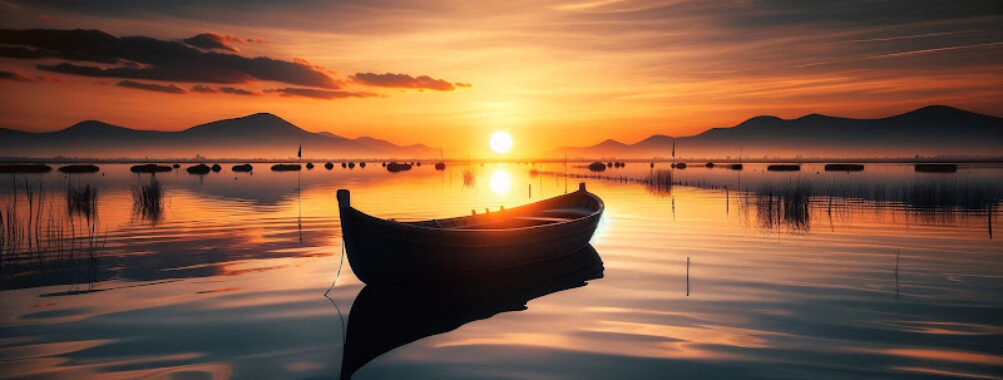
Parque Natural de la Albufera
Table of Contents
Description
Parque Natural de la Albufera is one of those places that quietly steals your heart before you even realize what’s happening. Declared a protected natural reserve back in 1986, it stretches across more than 21,000 hectares just a short drive south of Valencia. For travelers who crave a mix of raw nature, history, and authentic local culture, this park is a goldmine. It’s not just a lake or a wetland—it’s a living, breathing ecosystem that has shaped the traditions and daily life of the surrounding villages for centuries.
The park is divided into three distinct environments, each with its own personality. The restinga, a 30-kilometer sandy barrier, shelters the Devesa forest—a patchwork of dunes, pine groves, and Mediterranean shrubs. Then there’s the lagoon itself, La Albufera, a vast freshwater lake that feels almost timeless when you glide across it in a traditional wooden boat. And finally, the rice fields, or marjales, where endless green stretches eventually turn golden in harvest season. These paddies aren’t just pretty—they’re the birthplace of paella, and you can almost taste the history in every grain of rice grown here.
It’s fair to say that most people walk away from Albufera enchanted, though not everyone has the exact same experience. Some visitors rave about the sunsets that light up the water in fiery reds and oranges, while others feel the park is a bit too spread out or rustic if you’re expecting polished tourist infrastructure. Personally, I think that’s part of the charm—the imperfections make it feel real. You’re not in a theme park; you’re in a centuries-old landscape where fishermen, farmers, and migratory birds all share the same space.
Key Features
- One of Spain’s largest freshwater lagoons, covering over 21,000 hectares
- Three distinct ecosystems: sandy restinga with forests, the lagoon, and rice paddies
- Home to hundreds of bird species, including herons, flamingos, and rare migratory species
- Traditional wooden boat rides across the lagoon
- Cycle lanes and scenic hiking trails suitable for families
- Wheelchair accessible entrances and designated parking areas
- Picnic tables and shaded areas for relaxed breaks
- Historic connection to the origins of paella and Valencian cuisine
Best Time to Visit
If you ask me, the best time to visit Albufera depends on what you’re chasing. Spring is magical—the rice fields are flooded, and the reflections of the sky on the water make the whole place feel surreal. Summer, on the other hand, can be hot, but it’s also when you get those long golden evenings that are perfect for boat rides. Autumn brings the rice harvest, and the fields turn into patchworks of color. Winter is quieter, but birdwatchers love it because migratory species arrive in huge numbers.
And then there are the sunsets. Honestly, no matter when you go, the sunsets here are something else. I’ve seen a lot of sunsets in my travels, but the way the sky turns into a fiery canvas over the lagoon is unforgettable. If you only have one evening in Valencia, I’d say skip the city rooftop bars and head straight here with a camera—or better yet, just sit back and soak it in without one.
How to Get There
Reaching Parque Natural de la Albufera is surprisingly easy. It’s only about 10 kilometers south of Valencia, which makes it a perfect half-day or full-day escape from the city. If you’re relying on public transport, local buses (like line 24 or 25) will drop you close to the park. They’re cheap and fairly frequent, though not always the fastest option. If you’re renting a car, the drive is straightforward, and parking is available in several access points around the reserve.
Another fun way to get there is by bike. Valencia has a fantastic network of cycling lanes, and pedaling your way down to the park gives you a slow, scenic transition from urban streets to open countryside. I once did it on a slightly wobbly rental bike, and while I underestimated the summer heat, it was one of the most memorable rides of my trip. Just bring water… lots of it.
Tips for Visiting
First things first: wear comfortable shoes. Even if you’re planning just a short visit, you’ll probably end up walking more than you expect. And if you’re heading into the rice fields or marshy areas, don’t be surprised if your shoes get muddy—embrace it, it’s part of the experience.
Bring binoculars if you’re into birdwatching. The park is home to an impressive variety of species, and while you’ll spot plenty with the naked eye, the real magic happens when you zoom in. I once spent half an hour watching a heron stalking its prey, and it was oddly hypnotic.
Food-wise, don’t miss the chance to try local dishes in the nearby villages. Paella tastes different here—it’s not just a cliché, it’s genuinely better because the rice is grown right in the surrounding fields. If you’re adventurous, go for all i pebre, a traditional eel stew that locals swear by. It’s hearty, garlicky, and not for the faint of heart, but worth trying at least once.
For families, the park is very kid-friendly. There are gentle hiking trails, picnic areas, and boat rides that kids usually love. Just keep an eye out near the water, especially with younger ones. And yes, the park is accessible for visitors with mobility challenges, which makes it inclusive and easy-going for groups with mixed needs.
Finally, time your visit to avoid the hottest part of the day in midsummer. Early mornings and evenings are not only cooler but also when the light is at its most beautiful. And if you can, stay for sunset—you’ll thank yourself later.
Location
Places to Stay Near Parque Natural de la Albufera
Find and Book a Tour
Explore More Travel Guides
No reviews found! Be the first to review!